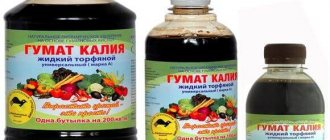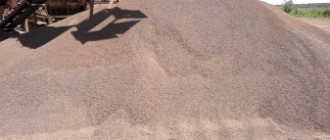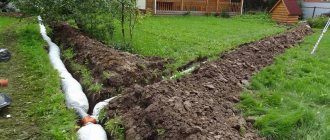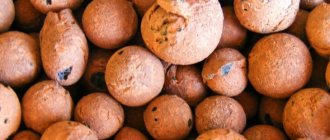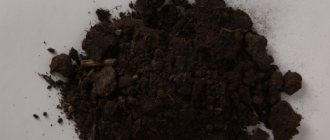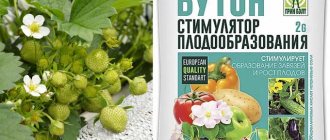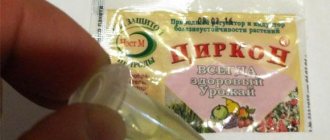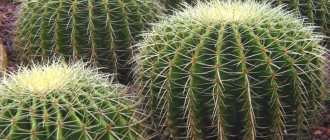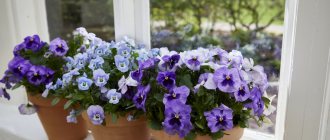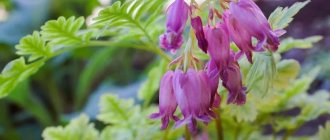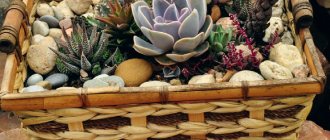Drainage and its purpose
Many houseplants require a soil composition that provides approximately 50% solids, 35% water and 15% air. Only a properly laid drainage layer will help recreate optimal conditions for growth and flowering.
The problem with lack of drainage is that overwatering displaces air, which is vital for flowers. The lack of oxygen in the soil provokes the development of pathogenic bacteria. The root system begins to rot and the plant withers. The drainage layer ensures the outflow of excess moisture and good breathability.
Indoor plants and drainage in pots
What can be replaced?
In indoor plant growing, the described material is used as drainage, placed at the bottom of the pot when planting and replanting plants, as well as a loosening agent for the soil mixture. In addition to expanded clay, plant growers use polystyrene foam, pine bark, brick chips, and small stones: gravel, river pebbles, and crushed stone for drainage. To make the soil mixture more loose, moisture- and breathable, expanded clay (if it is not available) can be replaced with crushed polystyrene foam or clean coarse sand. Another excellent natural leavening agent is copra - dry coconut fiber.
In indoor plant growing, special drainage materials of natural origin are used as a loosening agent for soil mixtures - vermiculite and agroperlite, which, like expanded clay, easily absorb moisture and release it to plants. This unique feature of these materials allows you to maintain an optimal supply of moisture in the soil, preventing it from becoming waterlogged and drying out.
What can be used as drainage
To lay drainage, you can use materials such as gravel, expanded clay, crushed stone, broken brick, peat, charcoal, river sand, polystyrene foam or any synthetics. An important quality of the drainage layer for indoor plants is good moisture permeability, inertness to chemicals, resistance to rotting and mold.
Drainage has different fractions, which are selected depending on the flower.
Expanded clay for flowers
A material with a porous structure, expanded clay, is baked clay. It is used in construction as an effective sound insulator and insulation. In floriculture, fine- and medium-fraction expanded clay is used. The main advantages are lightness and ability to absorb water. When the earthen ball dries out, the material releases moisture back into the soil.
Expanded clay is a chemically neutral, odorless material. It can be used several times. After about 6 years it crumbles into the ground. For drainage of large indoor plants, medium-fraction expanded clay (diameter 2 cm) is suitable. It is important that the size of the hole at the bottom of the pot is smaller than the fraction of the material. The optimal height of the drainage layer is 2 cm. If you are using a container without holes, then the expanded clay layer should be 5 cm. Sprinkle sand on top.
Layer of expanded clay in a pot
Ceramic shards
Pieces of ceramics will serve as a good drainage material for indoor flowers. Place several small shards or large pieces with the convex side up on the holes in the pot. Pour 1.5 cm of purified coarse sand on top into a small container, and 5 cm into a large container. The disadvantage of the material is the risk of damage to the roots by the sharp sides of the shards. You should not use pieces of ceramic that are too large, as sand will spill through them.
Ceramic shards
Perlite and vermiculite
The material vermiculite is produced by heating clay to high temperatures. As a result of heat treatment, minerals are pressed together, forming flakes. In appearance, vermiculite resembles wood or cork shavings. It is light, inert, and does not harm indoor plants.
Perlite is elastic silica of volcanic origin. It appears as white or gray granules. Both materials are capable of absorbing moisture with mineral and organic substances. They return water back to the soil as needed. The disadvantage of this type of drainage is its high cost.
Perlite and vermiculite
Sphagnum moss
Many gardeners use pure sphagnum moss as a drainage material. This natural drainage holds water well and releases it to dry soil. In addition, it has disinfecting properties. Moss grows on moist, swampy forest soils. It consists of soft stalks of light green light, from which the same soft needle-like leaves grow to the sides.
Sphagnum moss can be harvested in any season, but it is preferable to do it in the fall: this way it will better retain moisture during transportation. Before laying the drainage, the moss is filled with warm water (temperature about 45 degrees). This procedure saturates the material with moisture and gets rid of possible insects.
Store moss in the refrigerator or freezer. The material is first placed in a plastic bag, but not tightly closed to allow air access. It is important to note that when defrosted, moss does not lose its beneficial qualities. The only disadvantage of the material is its inaccessibility. It is not always available in flower shops, and getting to the forest for it is not always possible.
Sphagnum moss
Charcoal
Charcoal drains the soil well for indoor plants. It functions as a natural fertilizer and antiseptic. Charcoal prevents putrefactive processes, adsorbs salts, and regulates soil moisture saturation. Charcoal drainage also absorbs and retains water and minerals well.
Charcoal is a neutral, inert, lightweight and porous material. For drainage, it is laid out on the bottom of the planting container in a two-centimeter layer. It is advisable to take large fractions or such that they do not pass through the holes of the pot.
Charcoal drainage in a pot
Crushed stone and gravel
Good drainage for flowers is obtained from medium-sized fractions of crushed stone and gravel. These materials are perfect for small pots with indoor plants that are rarely replanted and moved from place to place. The main disadvantage of crushed stone and gravel is their heavy weight.
Gravel for turf
Broken brick
Broken clay brick is another option for good drainage for flowers. During production, various additives are added to the clay to improve its quality, and then fired. As a result, the natural material is strong and absorbs moisture well.
The main disadvantage is the sharp edges of broken bricks, which can damage the roots of a houseplant. It is better to sharpen the pieces a little before storing them. Instead of red ceramic brick, you can use silicate brick. It has more pronounced drainage properties.
Broken brick
Foam drainage
Foam can be used as a drainage layer. In every home there is at least one box of household appliances containing this material. Polystyrene foam is lightweight, does not absorb water, does not decompose, does not deform, is non-toxic, and has no odor. It is good to use in heavy ceramic flowerpots.
Excess moisture flows down the foam into the tray. To lay drainage, the material is cut into cubes and placed on the bottom in a layer of 2 cm. The disadvantage of polystyrene foam is that over time, the roots of indoor plants entwine the material. In view of this, when replanting there is a danger of damaging the root system.
Polystyrene foam as drainage
Sea or aquarium stone
An alternative to crushed stone and gravel is small sea or aquarium stone. It is great not only as a drainage layer in a pot, but also for decorating the soil of a houseplant. The only thing that can discourage a gardener from purchasing such drainage is the high price.
Sea stones as drainage for a flower
Expanded clay in crop production and at the dacha
Expanded clay - features of application on the site
Author: Victoria Solup
This material is well known to builders. But the construction of buildings is not the only area of application for expanded clay. Expanded clay gravel is widely used in gardening and landscape design.
You probably know what expanded clay looks like. This material is light particles with a melted surface and pores inside. Expanded clay is produced by firing clay or shale in special furnaces at temperatures from 1050 to 1300°C.
The color of expanded clay can be beige-gray, gray-brown, dark brown, terracotta
There are several types of expanded clay :
Expanded clay gravel with granules ranging in size from 10 to 20 mm is most often used in gardens and vegetable gardens.
Properties and advantages of expanded clay
This material has deservedly gained wide popularity not only among builders, but also farmers and landscape designers. What are the main advantages of expanded clay?
Using expanded clay in the country
Thanks to these properties, expanded clay is used as insulation in the construction of garden buildings (for floors, walls, roofs, basements) and as a mortar filler for foundations. And also during the construction of garden paths. This is especially true in areas located in wetlands.
A special pillow is made from expanded clay, which forms a dense layer and withstands strong pressure
But most often expanded clay is used in the garden, vegetable garden and landscape design. It serves as insulation and drainage for the roots.
Expanded clay gravel provides plants with comfortable growing conditions: it improves the structure of the soil, making it air- and water-permeable, protects plant roots from drying out in hot weather and mold from forming in rainy weather, reduces the risk of plant diseases, as well as the appearance of various pests.
Mulching with expanded clay increases the productivity of fruit, berry and vegetable crops
Expanded clay can also be used when growing various crops in hydroponics.
two ways to increase soil fertility using expanded clay :
Fine-grained expanded clay can also be used in the garden for mulching . This will help protect the soil surface from mold, as well as reduce the number of waterings and retain moisture in the soil for a long time.
In gardening, expanded clay is widely used for drainage under apple trees, pears, currants, grapes, etc.
Expanded clay in landscape design
Expanded clay not only brings great benefits to plants, but also performs a decorative function in the flower garden. Using this material, you can fill the resulting space in rock gardens and rockeries, and also, by filling in the holes, level the surface.
If traditional brown material seems boring, use decorative expanded clay painted in various colors
Now you know how to inexpensively increase soil fertility, relieve plants from stagnant water and poor air circulation, and create an attractive flower bed. Have a rich harvest and beautiful ornamental plants!
Source
Why are drainage holes needed in a flower pot?
In addition to proper drainage, it is important to find a good pot for planting. When purchasing a container, pay attention to whether it has drainage holes, what size they are and how they are located. If the holes are too small, the moisture will drain slowly, if they are large, the moisture will drain quickly. If there are no holes at all, they can be made at home using a drill with a suitable drill diameter.
To ensure the correct soil moisture for certain indoor plants, you should choose a container with the correct holes:
- For succulents, cacti and some types of orchids, moisture must drain quickly. A small pot with porous soil and small holes is suitable for them.
- For plants growing in high humidity, it is better to select containers with dense soil and a minimum of small holes.
Drainage holes in flower pots
Expanded clay for drainage
Expanded clay is baked clay with a porous internal structure. When the question arises of what to make drainage for flowers from, the first thing that comes to mind is expanded clay, since it is the most suitable for these purposes.
This material is also used in construction as insulation and sound insulator. In floriculture, medium- and fine-fraction expanded clay is used. Its main advantage is its lightness and ability to absorb excess moisture. When there is not enough of it, expanded clay releases water back into the ground.
This is a chemically neutral material, odorless. It can be used many times, after about six years it crumbles into the soil.
For large plants, medium-fraction (2 cm in diameter) expanded clay, on which sand is poured, is suitable for drainage. It is necessary to ensure that the size of the hole in the pot is smaller than the fraction of the drainage material. The optimal drainage layer is about 2 cm. If you decide to use a container without holes, then the expanded clay layer should reach 5 cm.
How to make a drainage layer
When the drainage material and planting container are prepared, you should proceed to installation. Step-by-step instructions on how to make drainage in a flower pot at home:
- Before starting work, make sure that all tools are clean and disinfected. Containers for planting must be dry.
- Before installation, carefully read the instructions for the drainage material; some of them require pre-soaking.
- Be sure to replace the drainage material with a new one when planting, transplanting, including during emergency procedures. If crushed stone or expanded clay is used, they should be washed, disinfected, dried, and then reused (maximum service life is 6 years).
- Select the layer height depending on the requirements of a particular plant. If the care recommendations do not indicate what kind of drainage is needed, then use low or medium. The usual drainage layer is 1–3 cm, medium – 4–5 cm, high – more than 5 cm.
- Adjust drainage height based on the number and diameter of drainage holes if necessary. If there is 1 large hole in the pot, then increase the minimum layer to 3 cm. For small holes, only high drainage is suitable. If there are many holes and they are large, then limit yourself to a layer 1 cm high.
- It is important that the drainage material lies evenly. To do this, tap the pot on the sides or shake it a little. If you are using shallow drainage, add a thin layer of soil on top. For coarse drainage material, add coarse sand.
- Completely cover the drainage layer and level the soil or sand. After this, proceed to transshipment or planting of a house plant.
Drainage layer
How to use in the garden?
To improve the soil, expanded clay is usually scattered around the site. The optimal volume is 5 l/m2. The bed is immediately dug up to mix the gravel with the soil. There is no need to rinse or sift it. Choose gravel with a size of 10-20 mm.
To plant seedlings, holes are made in the garden bed. So that they constantly receive nutrition along with moisture, to maintain a constant temperature, expanded clay is placed on the bottom.
| № | Helpful information |
| 1 | For vegetables, melons, and strawberries, drainage is made with a layer thickness of 5 cm. The pellets are mixed with soil, fertilizers and ash; carry out planting of seedlings |
| 2 | Expanded clay trees will require more, about 20 cm. It is recommended to mix it with sand |
| 3 | Drainage is also used when planting berry bushes. A layer 10 cm thick will be required |
To prevent soil waterlogging and overheating, prepare mulch. It is scattered in an even layer under the seedlings. With a mulch depth of 5 cm, the development of weeds can be avoided. Insects do not settle on gravel. This is good protection against pests and pathological microflora.
You can root seedlings and indoor plants in expanded clay. The material is environmentally friendly, but for watering it is recommended to use a nutrient solution with fertilizers. The chemical composition of expanded clay gravel is represented by oxides of silicon, aluminum, iron, calcium, potassium, and magnesium. They are washed out of the granules, but slowly.
Experienced plant growers claim that the roots of seedlings of tomatoes, cucumbers, peppers, and eggplants develop better on expanded clay. Seedlings never suffer from blackleg; they do not often need to be watered. The roots grow freely. For seedlings, it is recommended to use hydroponics, bottom watering or introducing a solution around the perimeter of the container.
Errors in the manufacture of drainage
Flower growers often make mistakes when making drainage:
- Do not use fine sand, which will clog the water drainage holes over time.
- You should not use large fractions, which do not retain moisture at all, and it immediately flows into the pan.
- Do not use natural materials that tend to rot, such as sawdust or tree bark. The rotting process often provokes plant diseases.
- It is not advisable to use marble chips. This material, when interacting with water, changes the acidity of the soil.
- It is not recommended to use materials with sharp edges: they can damage the root system of the plant.
Expanded clay in landscape design
Creating an effective landscape design involves using not only plantings, but also a variety of materials. One of these is expanded clay. It has been used among summer residents for quite some time, and in different situations. So, expanded clay can be used to mulch garden beds, and if necessary, it will provide good drainage. However, most often this material is used to decorate the local area.
Areas of use
Expanded clay is purchased at retail outlets where garden products are sold. It is in packages. They are usually labeled as "plant drainage" or floral drainage. Usually this is prepared crushed stone or gravel. It has already been washed and normalized for acidity.
It can be immediately used for indoor plants, hydroponics or in the garden plot. The manufacturer usually reports the pH of the material. The following companies represent expanded clay on the market:
The manufacturer sells drainage and pellets of a certain size. Plant growers do not need to select expanded clay and sort it by diameter. The material can also be purchased at a hardware store. At the same time, they pay attention to factions.
Material with grains up to 3-5 mm is sand. It is used in construction, as fillers for warm mortars. In plant growing, it is introduced to improve the soil. You can sow in sand, but this is rarely done. Sand is difficult to normalize for acidity. It must be soaked in water and reagents introduced. Then, it is sifted, but the granules are too small. For sowing it is better to use vermiculite or perlite.
Expanded clay gravel is round granules of a terracotta shade. Its scope of use is more extensive.
Pellets of 5-10 mm are used both in construction and in crop production. Expanded clay is used for aquariums. The material is laid as drainage for alpine slides during the construction of garden paths. It is introduced into the soil to maintain softness. Gravel is used as a decorative material.
Expanded clay 10-20 mm is actively used by home plant growers and gardeners. It can be introduced into the soil so that it retains moisture well and is loose. It is used to prepare drainage for indoor plants when growing vegetables on the balcony.
In medium-fraction gravel, seedlings are rooted and flowers are grown. This is a good substrate for hydroponic plants. The material is light. It does not weigh down the structure. The pellets are placed in flower pots, in the garden under trees and shrubs for mulching.
Material with granules of 20-40 mm is used mainly in construction for insulating roofs, floors, and foundations.
Gardeners consider it for drainage of trees and large shrubs. The pellets are large, they are inconvenient to place in a flower pot and introduce into the soil mixture, but they can be laid on top of the soil to maintain moisture in it. They look beautiful in a pot or in the garden.
What can it be made from?
Let's list a list of materials suitable for creating a drainage system and find out which one is better and how to prepare them correctly. Florists usually use the following as drainage materials:
- Ceramics . Old ceramic pots can be used to build drainage. It is enough to split them into small shards and disinfect them. The fragments are placed at the bottom of the pot with the convex part up. They shouldn't be too large. The downside is the presence of sharp edges.
- Expanded clay . This is one of the best and inexpensive drainage materials. It easily removes moisture and also absorbs it, giving it to the plant as needed. Expanded clay drainage does not have sharp corners, and therefore it is safe for the root system. However, it needs to be disinfected before use. No cons noted.
- Moss . Sphagnum moss can be collected from a swamp or bought at a flower shop. This is not only a drainage material, but also a good disinfectant and moisture-retaining agent. Before laying on the bottom, it must be soaked for 30 minutes in warm water. The downside is the fragility. But given that plants require frequent replanting, this is not a problem. Another drawback is that the roots grow through the moss. Therefore, it will be almost impossible to separate them from each other in the future.
- Charcoal . This is not only drainage, but also fertilizing, as well as a moisture-retaining agent and material that absorbs salts and disinfects the soil. Coal is placed on the bottom of the pot in large pieces. There are no cons. But there is a nuance - it alkalizes the soil. And this is harmful if the plant prefers a slightly acidic or acidic soil reaction.
- Vermiculite . It absorbs water along with nutrients. Therefore, the plant will be fed every time the material begins to release moisture. There are no cons.
- Perlite . This is another one of the best materials for creating drainage. But it's expensive. Perhaps this is its only drawback.
Important! The drainage system includes two layers. The first is the drainage material itself, and the second is a layer of sand. If it gets into the space between the stones, it’s not a big deal. After all, sand is permeable. If it were soil, then after compaction the outflow of water would be disrupted.
Drainage for indoor plants
Properly created drainage is a kind of foundation on which the future health and well-being of all indoor plants, without exception, is based. The amount of moisture and air that is necessary to ensure the normal life of the flower will depend on it. Lack of drainage combined with improper watering is the most common cause of death of many indoor plants. So what is drainage?
Almost all beginning flower growers believe that drainage is the same expanded clay that is sold in stores. That it is enough to pour some of it on the bottom of the pot, and the job is done. This is a big misconception. Good drainage for a houseplant requires the correct amount of drainage material and a correctly selected and prepared pot for planting. The material of the pot, the number and diameter of the holes are an integral part of high-quality drainage.
What is expanded clay?
This is a natural material made from clay or shale, fired in a kiln at a temperature of 1200 °C. Contrary to popular belief, there is no division into construction and floral expanded clay - they are the same material.
On sale you can find granules of large (2–4 cm in diameter), medium (1–2 cm) and small (0.5–1 cm) fractions, as well as expanded clay sand (less than 0.5 cm). The granules, smooth on the outside, have a porous structure on the inside - they weigh little, do not interfere with air exchange and are able to accumulate and release moisture.
Drainage materials
Only materials of inorganic origin are suitable for creating a drainage layer. Moreover, they must be chemically neutral and have good resistance to destruction and oxidation. For example, marble chips are absolutely not suitable for drainage, since with prolonged interaction with water, they significantly reduce the acidity of the soil, making it excessively alkaline. Fine materials, such as gravel or sand, are also not particularly suitable as primary drainage. Over time, they become thoroughly compacted and clog the drainage holes.
Main characteristics
Expanded clay pellets are porous. They have a lot of air. The material is introduced to maintain the soil in a soft state. Both gravel and crushed stone are used. Expanded clay supports normal gas exchange processes for plants.
It is used both in garden beds and for preparing soil mixtures for seedlings and for growing indoor flowers.
The pores of crushed stone can fill with water. The material is hygroscopic. Water is retained in the pores for a long time. Expanded clay releases moisture to plants gradually, maintaining a constant water balance in the soil. This is especially important for moisture-loving flowers and garden crops.
